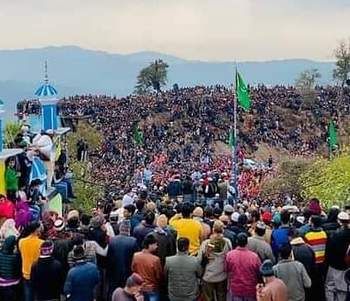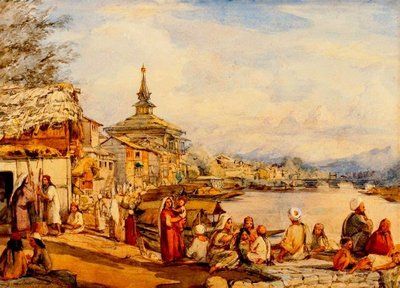
Publisher:
Bonnie King
CONTACT:
Newsroom@Salem-news.com
Advertising:
Adsales@Salem-news.com

~Truth~
~Justice~
~Peace~
TJP
Jan-11-2021 01:52

 TweetFollow @OregonNews
TweetFollow @OregonNews
UN Must Take Swift Action for Peace in Kashmir
Harris Khan, special to Salem-News.comJammu & Kashmir are a flashpoint in the fast-changing global scenario.
 Thousands of devotees assembled to observe annual Urs of Sufi Saint Hazrat Nanga Baji Sahib [RA]. Baji Syed Muzaffar Shah Sahab prays for peace in Jammu and Kashmir. Jan 9, 2021 Photo by: @RajouriTown |
(LONDON) - When someone mentions Kashmir, your first thought is likely a region with bloodshed, torture, mass graves, women rape, human rights violations, children losing their eyesight as young as 5-years old due to pellet guns, and the biggest prison on this planet.
But that’s not how Kashmir used to be known. Once, Kashmir was the hottest holiday destination for local and western people because of its natural beauty.
The land of Kashmir was not just blessed with natural beauty but also one can encounter inexpressible hills, mountains tenderly rising far to protect the land's meadows with the delicate scent and the gentle sun, the drooping snow and the chilly winters, apple orchards and beautiful natural lakes.
One would see this land full of joy happiness peace and always smiling. Many poets have termed Kashmir as a heaven on earth because of her mesmerized beauty.
Instability in Kashmiri began in 1846 when the British sold Kashmir to Dogra Maharaja Gulab Singh under the Treaty of Amritsar, at a cost of 7.5 million Nanakshahee rupees (currency that time). Gulab Singh was then bestowed with the title of Maharaja. Since then, Kashmir has been in a state of dilemma and torture.
The Maharaja rule was one of the most brutal periods the Kashmiri people ever faced. After all these years, Kashmiri has continued to be engaged in a genuine freedom struggle.
In 1931, on the 13th of July, local people were raising their voices against the ruler, demonstrating peacefully outside the central jail against unlawful killings and arrests.
The Maharaja rule authorities tried to disperse the demonstrators but failed and opened a fire on unarmed local people where 21 young Kashmiris died.
The martyrs of July 13th 1931: 1. Khaliq Shora 2. Akbar Dar 3. Ghulam Ahmad Rather 4. Usman Misgar 5. Ghulam Ahmad Bhat 6. Ghulam M Halwai 7. Ghulam Nabi Kalwal 8. Ghulam Ahmad Naqash 9. Ghulam Rasool Durra 10. Ameer-ud-Din Makayi 11. Subhan Makayi 12. Ghulam Qadir Khan 13. Ramzan Chola 14. Ghulam Mohammad Sofi 15. Naseer-ud-Din 16. Ameer-ud-Din Jandgaru17. Mohammad Subhan Khan18. Mohammad Sultan Khan 19. Abdul Salam 20. Ghulam Mohammad Teli 21. Fakeer Ali 22. Ghulam Ahmad Dar 23. Mughli 24. Abdullah Ahanger.
From this day in 1931 until now, July 13th is remembered as a martyred day. Every freedom struggle has a catalyst and for the Kashmiris this was it.
On the 15th of August 1947 when both Indian and Pakistan gained independence from Great Britain, Kashmir initially decided to remain independent, choosing not to become a part of either Indian or Pakistan.
In October 1947 both India and Pakistan fought over Kashmir and divided the region into two parts: one-part India occupies and the other part is under Pakistan. This begins the first war between India and Pakistan.
 Khanqah-e-Moulah in 1853 |
On the first of January 1949 both Indian and Pakistan agreed to withdraw all their troops behind a mutually agreed ceasefire line because of UN participation.
The same ceasefire line later became the line of control and both India and Pakistan agreed to give Kashmiris the right to decide their future through a free and fair plebiscite1 which was never fulfilled. Hence, the two states had two more wars over Kashmir in 1965 and 1971.
Now both countries with the Nuclear Weapons and unsolved Kashmiri dispute hanging on their heads makes the whole South Asian region very fragile. The Kashmiri people have been suffering from occupiers for decades. They have knocked on every single door to fulfill the plebiscite promise, made by both India and Pakistan at the UN but failed.
Then, in 1989 young Kashmiris began demonstrating in Srinagar and its surrounding areas against India’s attitude for not giving local people the right to decide their future.
To squash any uprising in Kashmir valley, India has sent thousands of security forces to Kashmir making it one of the most highly militarized regions in the world.
Continued strikes, demonstrations and uprising against New Delhi was a daily routine. Peaceful public rallies were handled with violence by security forces which began the armed struggle against Indian security forces.
New Delhi accused its arch-rival Pakistan for the unrest in Kashmir but Pakistan denied any involvement.
Tens of thousands of people have lost their lives in Kashmir since the insurgency took place. New Delhi sent more troops to Kashmir and increased Police as well. Currently India has over 800,000 soldiers and around 300,000 police deployed in Kashmir.
Once described a paradise on earth has turned into hell. The region looks a battle ground, buildings are riddled with bullet marks, roads and infrastructure have not been improved in years.
Children are growing up not knowing the meaning of peace but have witnessed the brutality of Indian forces towards their families.
When talks between the Indian government and parties at the Hurriyat conference began in 2004 to stop the bloodshed in Kashmir, the problem was hardly resolved.
Many young Kashmiris had enough and they have taken their fate in their own hands and fight for their freedom. The Chatham House poll in 2010 found that between 74 percent to 95 percent of residents of the mainly Muslim Kashmir Valley, where the conflict is centered would vote for independence. In mostly Hindu Jammu, that support dropped to 1 percent.
Kashmiri people have sacrificed many generations to this conflict but now the Kashmiri struggle has taken a new step. Young Kashmiris have taken this struggle into their own hands and they say resistance is a way of life for them.
The youth of Kashmir are behind the recent uprising in Kashmir and now openly use social media and raise their anger against the Indian forces.
In July 2016, Indian forces killed a 21-year-old Kashmiri youth sparking a furious civilian uprising across the Kashmir valley.
The Indian state has responded with singular ruthlessness killing more than 90 people. They have been breaking up the demonstrations with non-lethal pellet ammunition which has blinded hundreds of Kashmiri youths.
2016 was the bloodiest year for Kashmiris; in four months nearly 20,000 adults and children were injured, nearly five thousand were arrested and an entire population spent the summer under the longest curfew in the history of curfews in Kashmir valley.
These actions were condemned by the world and requested India to let human rights organisations enter in Kashmir.
Kashmiri people are raising human rights violations on social media and forcing western media to pick up on this issue and they have been very successful. During the last 30 years of the conflict in Jammu & Kashmir over 100,000 innocent lives of young, old, men and women have been lost.
Kashmiri people are dying every day according to Kashmir Media Service. Jammu & Kashmir are becoming a flashpoint in the fast-changing global scenario, further delay in the settlement of the Kashmir dispute might prove catastrophic for regional peace.
It’s about time the United Nations intervened to stop the systematic genocide of Kashmiri people by the Indian occupation forces.
India is blatantly violating the United Nations Security Council resolutions on Kashmir and I urge the UN to take swift action to fulfill its promise to organize the plebiscite in Jammu & Kashmir under its supervision.
1:the direct vote of all the members of an electorate on an important public question such as a change in the constitution.
 Harris Khan (HK)is UK based writer who enjoys reading and writing about Geo Politics. HK went to university in Manchester (England) to study IR & Politics. He received his first honours degree in International Relations & Politics in 2011, add to this HK also have achieved a Master degree in Terrorism and Security, this has given him the understanding in regards to global terrorism.
Harris Khan (HK)is UK based writer who enjoys reading and writing about Geo Politics. HK went to university in Manchester (England) to study IR & Politics. He received his first honours degree in International Relations & Politics in 2011, add to this HK also have achieved a Master degree in Terrorism and Security, this has given him the understanding in regards to global terrorism.
During HK’s academic years, he studied South Asian and Middle Eastern Politics including Arab Israel conflict. HK also chosen to write his postgraduate Thesis on the root causes of Kashmiri conflict. Master’s thesis has enormously encouraged HK’s writing skills, and since that he is focusing on Middle East and South Asian Politics particularly on Kashmir, Afghanistan and Pakistan. HK is aiming to highlight the human rights violations in that part of the world including positive aspect which is sadly ignored by the west alongside main stream media.
Articles for January 10, 2021 | Articles for January 11, 2021 | Articles for January 12, 2021
Quick Links
DINING
Willamette UniversityGoudy Commons Cafe
Dine on the Queen
Willamette Queen Sternwheeler
MUST SEE SALEM
Oregon Capitol ToursCapitol History Gateway
Willamette River Ride
Willamette Queen Sternwheeler
Historic Home Tours:
Deepwood Museum
The Bush House
Gaiety Hollow Garden
AUCTIONS - APPRAISALS
Auction Masters & AppraisalsCONSTRUCTION SERVICES
Roofing and ContractingSheridan, Ore.
ONLINE SHOPPING
Special Occasion DressesAdvertise with Salem-News
Contact:AdSales@Salem-News.com



Salem-News.com:

Terms of Service | Privacy Policy
All comments and messages are approved by people and self promotional links or unacceptable comments are denied.
[Return to Top]
©2026 Salem-News.com. All opinions expressed in this article are those of the author and do not necessarily reflect those of Salem-News.com.